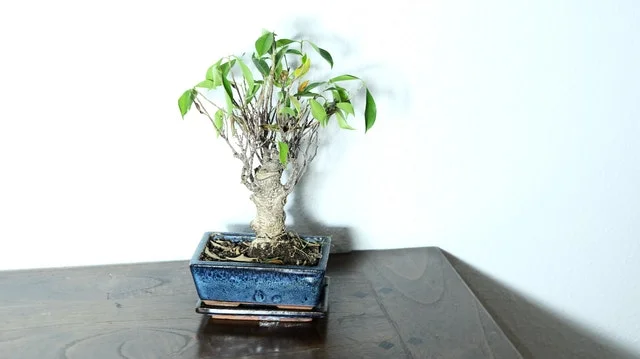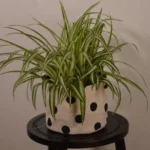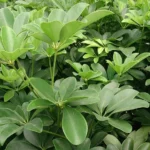The schefflera bonsai, also called the Hawaiian umbrella tree, is not a true bonsai tree. It is, however, the most common “bonsai” tree to grow indoors. This particular species is a lovely one to choose for its appearance and its ease of care.
Like a true bonsai, these trees can be trained, and it can look like the real thing, with their shorter stalk, clusters of branches, and wide-spreading deep green leaves.
Table of Contents
How To Care For Schefflera Bonsai
Aside from being beautiful and compact, one of the reasons for choosing to house a schefflera bonsai is the minimal level of care required. These are resilient plants and can tolerate a variety of environments.
What does your schefflera bonsai require?
While these trees are considered low maintenance, they have some required provisions for them to be healthy. Here is a look at these requirements.
Light Requirements
While it prefers medium to bright indirect light, surprisingly, this plant can thrive in low-lit areas.
Because this tree is more vigorous than other plants, including true bonsai trees, it lives longer than the others, even with less light.
Temperature Requirements
The optimal temperatures range between 18-22 degrees Celsius (65-72 degrees Fahrenheit). They can tolerate temperatures as low as 10 degrees Celsius (50 degrees Fahrenheit.
These plants should not be exposed to temperatures lower than 10 degrees Celsius (50 degrees Fahrenheit), or they could be damaged.
Humidity Requirements
Schefflera bonsai plants prefer moderate humidity. They can adapt to other levels, even those that are quite low, but they grow better at higher levels.
The training of the leaves and stems also progresses better with higher humidity levels.
Water Requirements
While care must be taken not to overwater these plants, they do prefer moist soil. It must not be permitted to dry out.
Water is not required as much during the winter unless it is placed in a heated area. In this case, it must be noted not to let the rootball dry. A sign of overwatering is yellowing leaves, while a symptom of under-watering is drooping leaves.
Soil Requirements
These trees prefer a potting mix that consists of bark and inorganic material that is kept moist. Free-draining soil also works well.
Fertilizer Requirements
A liquid fertilizer applied every week between the spring and fall is optimal for the health and growth of these trees.
Solid organic fertilizer may be given as well during the summer months. During the winter, dosing should be reduced to once per month.
Extra Tips For Schefflera Bonsai
This umbrella plant does not require a lot of care to be healthy and thrive, as long as it has enough water.
However, to ensure it stays as healthy as possible, and to prune and propagate correctly, here are some additional tips to help.
Pests and Diseases
Moisture tends to attract some insects and that is the most common reason for issues that may arise. However, schefflera bonsai are fairly resilient.
It is possible to have such plants without experiencing any difficulty with either of these problems.
- Mealybugs: These small pale pink or white insects feed off the stems and leaves. They tend to settle under the leaves, where they also leave a wax or cotton-like substance. Such insects can be difficult to remove once the infestation becomes larger. Individual mealybugs can be killed by dabbing rubbing alcohol on them. The presence of many insects may require an insecticide such as natural neem oil.
- Spider Mites: These little spides, often white, red, or black, suck the sap from the leaves, making the plant malnourished, like the mealybugs. The arachnids leave wispy webs over the leaves, sometimes the first sign of an issue with the pests. Insecticides are usually required to deal with infestations.
- Aphids: These insects multiply quickly and can overcome the plant if they are not eliminated within a short time. Other than seeing the small creatures, a sign of their presence is the clear sticky substance they leave on the leaves. Insecticides like neem oil or insecticidal soap are usually used to eliminate the problem.
- Scale: Yet another insect that feeds on the plants’ sap, this particular pest looks like small bumps on the leaves and stem. When several are present in the same spot, they may appear to be several scales, which is where they got their name. One particular symptom of these pests is the yellowing of the leaves. An insecticide is required to deal with these pests.
- Root Rot: This fungal disease causes discoloration of leaves and stems. They may become soft and mushy. It also causes a blackening of the trunk. Root rot is almost always advised to be treated with the removal of the damaged parts, the application of fungicide, as well as the repotting of the plant into fresh potting soil in a new pot.
In any of these cases, as well as with other insect or illness issues, the damaged plant parts must be removed. This action helps the plant to become healthier once again.
Pruning
Pruning not only removes dead or damaged stems and leaves but also encourages healthier growth. In terms of the schefflera bonsai, it assists in creating the true bonsai appearance.
To create the bonsai appearance, all of the leaves need to be pruned, with just the stalk remaining. The following year, just the larger leaves should be cut.
This can be repeated each spring until the desired leaf size has been achieved.
Aerial roots grow from the trunk, but these can be trimmed to shape the tree is preferred. This snipping helps in creating the bonsai appearance also. The roots can be removed altogether if the caregiver prefers the thicker roots.
Any cutting, whether for reducing leaf size or removing damaged leaves, should be done using sharp sterile scissors or pruning shears.
The instruments should be sterilized after each cut, especially in the case of removing damaged areas.
Propagation
Schefflera bonsai plants can be propagated from cuttings or seeds. If using cuttings, a stem may be cut from the mother plant using sterilized sharp scissors or pruning shears. A cutting will sprout roots whether they are planted in soil or kept in water.
If planting the cutting in soil, it should be placed in the pot with a moist granular potting mix before wrapped in plastic. After four to six weeks, the roots will have sprouted and the pot can be removed from the plastic.
Toxicity
Schefflera bonsai plants are toxic to humans and animals. Ingestion may cause nausea, vomiting, tremors, and respiratory problems.
Topical contact may cause skin irritation. These plants should be kept out of reach of children and pets. Wearing gloves while working with schefflera bonsai plants is advised.
Photo by Skylar Kang from Pexels



